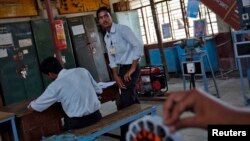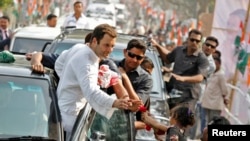NEW DELHI —
In India, an estimated 120 million first-time voters will be eligible to cast ballots in elections starting next month. In one of the world’s youngest countries, those under 25 are increasing their political involvement as they seek to turn the spotlight on issues critical to them - jobs and development.
In 2011, Sanjay Kharwar, an engineering student at the prestigious Indian Institute of Technology in New Delhi, squatted in a public park in the heart of the capital along with tens of thousands of other young people taking part in massive civil society anti-corruption protests.
This year, Kharwar will go to the polls for the first time. But he wants to do more than just cast his ballot. He wants to play an active role in giving his country a new direction.
“In my generation we are not thinking of caste or region, people like us are going away from old philosophy of caste, creed, we are thinking of economic development, this is good for the country,” he said.
Kharwar has enrolled as a volunteer for the opposition Bharatiya Janata Party because he feels its prime ministerial candidate is best suited to address issues that matter most to young people: good governance, faster growth and jobs.
He is among thousands of college students and young professionals signing up to campaign for political parties across the country, whether for the ruling Congress Party, the BJP or a host of smaller parties vying for the 543 elected seats in parliament in elections starting April 7.
India has the highest number of young people in the world - about half its 1.2 billion people are under 26. They were given scant attention by political parties until they emerged on the forefront of two of the biggest civil society campaigns seen in recent times: the anti-corruption movement, and the spontaneous protests following the brutal gang rape of a young student in Delhi in December 2012.
Those protests prompted political parties to take notice of India’s young. And as they gear up for the polls, the parties are trying to mobilize these voters.
The Congress Party hopes that the youthful image of its lead campaigner, 43-year-old Rahul Gandhi, will attract the young in a country where politics has been dominated by much older people. Gandhi has been pushing for younger candidates and wooing young voters in his rallies.
The BJP hopes its strong focus on development will carry the day with young voters.
“There is unemployment. There is lack of investment. There is inflation. Therefore people want change. There is a yearning for change …and it that way we are targeting the youth of the country,” said Ravi Shankar Prasad, a top leader of the Bharatiya Janata Party.
However, political analysts say the two main parties have failed to address the fundamental issues that matter to young people with concrete programs.
Sanjay Kumar at the Center for Developing Societies in New Delhi, who has authored a book on Indian youth in politics, says political parties are only paying “lip service to the young”.
“In order to mobilize young voters, what they are doing now is to give more tickets to younger people and that is not enough to mobilize young voters in favor of a party," he said. "They don’t realize they need to do address the interests, issues, demands of young voters, how they are going to solve the problem of unemployment, of better facilities of education. No political parties have paid attention to the aspirations, anxieties, of young voters in the country.”
Kumar says compared to a decade ago, young people - both men and women - are showing more interest in politics.
“I would say young voters across localities, they have started participating more and young voters across gender. That is the change we have seen,” he said.
While some of the young volunteers for political parties have political ambitions, others like Kharwar do not. Still, they are willing to take time out to campaign for their chosen parties as they organize campus meetings, use social media aggressively and hop on to crowded metro trains to make their point of view heard in the 2014 polls.
In 2011, Sanjay Kharwar, an engineering student at the prestigious Indian Institute of Technology in New Delhi, squatted in a public park in the heart of the capital along with tens of thousands of other young people taking part in massive civil society anti-corruption protests.
This year, Kharwar will go to the polls for the first time. But he wants to do more than just cast his ballot. He wants to play an active role in giving his country a new direction.
“In my generation we are not thinking of caste or region, people like us are going away from old philosophy of caste, creed, we are thinking of economic development, this is good for the country,” he said.
Kharwar has enrolled as a volunteer for the opposition Bharatiya Janata Party because he feels its prime ministerial candidate is best suited to address issues that matter most to young people: good governance, faster growth and jobs.
He is among thousands of college students and young professionals signing up to campaign for political parties across the country, whether for the ruling Congress Party, the BJP or a host of smaller parties vying for the 543 elected seats in parliament in elections starting April 7.
India has the highest number of young people in the world - about half its 1.2 billion people are under 26. They were given scant attention by political parties until they emerged on the forefront of two of the biggest civil society campaigns seen in recent times: the anti-corruption movement, and the spontaneous protests following the brutal gang rape of a young student in Delhi in December 2012.
Those protests prompted political parties to take notice of India’s young. And as they gear up for the polls, the parties are trying to mobilize these voters.
The Congress Party hopes that the youthful image of its lead campaigner, 43-year-old Rahul Gandhi, will attract the young in a country where politics has been dominated by much older people. Gandhi has been pushing for younger candidates and wooing young voters in his rallies.
The BJP hopes its strong focus on development will carry the day with young voters.
“There is unemployment. There is lack of investment. There is inflation. Therefore people want change. There is a yearning for change …and it that way we are targeting the youth of the country,” said Ravi Shankar Prasad, a top leader of the Bharatiya Janata Party.
However, political analysts say the two main parties have failed to address the fundamental issues that matter to young people with concrete programs.
Sanjay Kumar at the Center for Developing Societies in New Delhi, who has authored a book on Indian youth in politics, says political parties are only paying “lip service to the young”.
“In order to mobilize young voters, what they are doing now is to give more tickets to younger people and that is not enough to mobilize young voters in favor of a party," he said. "They don’t realize they need to do address the interests, issues, demands of young voters, how they are going to solve the problem of unemployment, of better facilities of education. No political parties have paid attention to the aspirations, anxieties, of young voters in the country.”
Kumar says compared to a decade ago, young people - both men and women - are showing more interest in politics.
“I would say young voters across localities, they have started participating more and young voters across gender. That is the change we have seen,” he said.
While some of the young volunteers for political parties have political ambitions, others like Kharwar do not. Still, they are willing to take time out to campaign for their chosen parties as they organize campus meetings, use social media aggressively and hop on to crowded metro trains to make their point of view heard in the 2014 polls.

